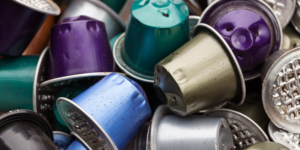Coffee pods can actually be quite beneficial for the environment, according to some studies
It may be difficult to find the right combination of green and espresso if you are looking to combine your love for coffee pods with your desire to be green.
Single-shot coffee pods can be harmful to the environment. They require energy to grow the beans and make the capsules. However, there is an upside to capsules: they are more sustainable than almost any other way of making espresso. Research has shown that recycled aluminum capsules are more eco-friendly than all other types of capsules, regardless of whether they are made out plastic or from compostable materials.
These capsules, whether from Nespresso, Lavazza, Illy, Bosch Tassimo, Green Mountain Coffee Roasters, Nestle or a bevy of smaller companies, have quickly conquered the world; even connoisseurs and many Michelin-starred restaurants have opted for them.

In the US alone, sales of coffee pod machines have soared during the past decade, from 1.8 million units in 2008 to 20.7 million in 2018, according to market research firm Euro monitor. By now, more than 40 per cent of US households own an espresso pod machine; in the UK, it’s nearly one third. Green campaigners, however, have been critical of the rapid adoption of the coffee pods, criticizing the deluge of waste streaming from the pod-powered coffee makers. According to research by Halo, a British producer of compostable coffee capsules, every minute about 39,000 of these pods are made worldwide, while up to 29,000 are dumped in landfill sites.
Although it may look bad for the environment, that is not all. It is important to do life-cycle assessments for all coffee-making methods in order to understand the environmental impacts of our coffee habit. Alf Hill, Professor of Chemical Engineering at the University of Bath looked at every stage of coffee production from growing the beans to disposing of the waste. He also assessed the impacts on water, ecosystems, and climate change.
His team found that instant coffee comes out best, but that capsules are the runner up in the environmental impact stakes. Filter or drip coffee comes third, while traditional espresso has the worst environmental impact. “The impact, such as greenhouse gas emissions, water and fertilizer use, mostly occurs where the coffee is grown,” says Hill. “Capsules tend to need less coffee input to make a single drink and so their overall impact can be lower even though we see more waste when we throw them away.”
Maxwell Colonna–Dashwood is a barista who co-owns Colonna & Small’s specialty coffee shop in Bath. He collaborates with researchers and says that instant coffee extracts a lot of coffee from the bean so it uses less coffee per mug, although he also notes that it doesn’t necessarily perform well on other sustainability aspects.
Hill’s research is consistent with other studies that have been done over the past few decades, which show that capsules are more environmentally friendly than other methods of brewing coffee. Apart from the environmental impacts of growing coffee beans, the energy required to make it is the second most damaging. This is why barista-made espresso has such a poor environmental record. To make a single cup of espresso, it takes a lot more energy. Capsules on the other side are more efficient. The coffee machine only heats the required amount of water for one serving, which is not like boiling water.
Sebastien Humbbert, who is an expert in lifecycle assessment studies for Quantis and works with many organizations to improve their sustainability. He cautions that drip-filter can still have a less harmful impact than capsules but that this depends on the individual. “But, if the drip filter machine is extremely inefficient and you leave it on, making more coffee than needed can lead to drip-filter being significantly less effective than capsules,” he states.
Colonna-Dashwood claims that, despite numerous studies showing that espressos and drip coffee are worse for the environment that capsules, the general public doesn’t seem to notice. The majority of people are focusing on how capsules are destroying the environment. “A lot of effort is being put into making capsules more durable — because people believe they are bad and it’s not because it’s a really unsustainable way to drink coffee. He says it’s ironic.
Quantis conducted a study that compared electricity usage during the brewing, heating, and waste of coffee for single-serve as well as drip coffee preparation. Quantis found that single-serve coffee requires a precise amount of coffee. This reduces coffee waste. However, drip coffee makers often end up with a lot of coffee leftovers that they don’t use. Espresso makers that use a hot plate or gas hob to make espresso are more efficient than those using capsule machines.
KTH in Stockholm found that filter coffee has the most negative environmental impact. Filtered coffee requires seven grams of beans to make a cup. Capsule coffee only uses 5.7 grams. This adds up to billions upon billions of cups of coffee consumed each year around the globe. It quickly increases the need for coffee beans to be grown, harvested and processed, as well as the energy required to heat the water.

Colonna Dashingwood’s coffee shop is close to Bath University. Students and professors often visit the shop. Sometimes, he talks with them about coffee, science, and coffee. Chris Hendon, a Chemistry PhD student, was one of the many people he made a latte in 2012. They had a conversation about how the water composition affected the taste of coffee. After that, he and Chris collaborated on a paper in Journal of Agricultural Food Chemistry. Later, he published Water for Coffee.
Colonna-Dashwood contacted Bath scientists last year. Hill, from the chemical engineering department, approached Colonna-Dashwood and asked him which capsules were best: plastic, aluminum or compostable. Colonna-Dashwood says that the result was that there are aluminum capsules.
Plastic capsules make up the majority of the market. They are most commonly manufactured by Lavazza and Nestle, Illy. Some plastic capsules are recyclable, like the mixed plastic ones made by Nestle’s Nescafe Dolce Gusto. L’Or Tassimo plastic caps are recyclable but must be dropped off at one of the 180 drop-off points around the UK. K-Cups made in the USA have aluminum tops. They can be partially recycled once they are taken apart. K-Cup pods in Canada are now recyclable. Katie Gilroy, spokesperson for Keurig, stated that all pods will be made from polypropylene number five plastic which is widely accepted as a recyclable material.
Nespresso has been producing its own aluminum capsules since 2010. However, just like L’Or plastic capsules there’s a catch. Customers must return the capsules to Nespresso for processing at the company’s recycling facility. Because Nespresso capsules don’t contain pure aluminum, which can be widely recycled, but they have a silicon lining that requires a custom recycling process. The company offers free return bags to customers who purchase capsules. This is to encourage them to be more environmentally conscious. Crosskey says that you can also drop your used capsules off at any Nespresso boutique at one of the 7,500 collection points, including CollectPlus or Doddle locations. Or request a collection at your home. The recycling rate at the moment is 25%.
Nespresso conducted a pilot recycling program with London’s boroughs of Kensington and Chelsea for six months in 2017. The company provided purple bags for residents to collect their Nespresso capsules during regular recycling rounds. In a similar vein, the company began working with Sims Municipal Recycling and the New York City Department of Sanitation in March 2019 to increase recycling rates.
Colonna-Dashwood claims that although Nespresso’s recycling facility is excellent, customers are still burdened with the extra work and hassle that comes with it. This means that adoption rates for Nespresso products aren’t as high as they should be. Even though the company’s aluminum capsules can be recycled in your regular household bin, each coffee pods must be empty first. Piotr Barczak is the senior policy officer for waste at the European Environmental Bureau. This network includes more than 143 environmental citizen’s organizations. He says that consumer behavior plays an important role.
“Coffee pods manufacturers claim that their products can be recycled, and they are correct. Barczak states that the problem is that many coffee drinkers don’t bother to recycle their capsules because they are difficult to collect and complicated to recycle. Although a refundable deposit fee could encourage more people to return the capsules than currently exists in the Nespresso business model, it is not in the plans of the company or its competitors.
Colonna-Dashwood believes that Nespresso, and other companies, could switch to recyclable aluminum caps. This would make it easier for consumers to throw out their coffee waste in the compost bin, and the capsules into the recycling bin. Hill and his research found that this would be the most environmentally-friendly option, with the exception of instant espresso, which performs best in all life cycle assessment studies.
However, it is unlikely that Nespresso will decide to eliminate silicon from its capsules. The company believes that bespoke recycling is based on intellectual property. Silicon capsules are patentable, which was originally used to stop other pod makers from using Nespresso machines. However, this strategy was stopped by a lawsuit. “So, if they copied us or got rid of the silicon lining, they would lose what they consider a competitive advantage. Colonna-Dashwood says that they are sticking to their IP. He also said that even after the lawsuit, the Nespresso machines were made in such a manner that Nespresso capsules are most comfortable.
Humbert concurs that aluminum capsules would be more sustainable if they were fully and widely recyclable (even though plastic ones can also be recycled). The most recent Quantis research shows that making plastic pods takes less energy than making aluminum ones. So, unless these are more widely recycled then plastic capsules may prove to be better.
Recent research has shown that plastic bags claimed to be biodegradable can hold shopping for three years even after being left in the ground or the ocean. Plastic pods, on the other hand, have a much shorter lifespan.
What about compostable capsules, you ask? Humbert and Colonna-Dashwood agree that compostable capsules are not good because they are seldom properly disposed of. It is not beneficial to compost a compostable container that has been placed in a municipal incineration facility. Humbert says that people often believe compost is better than plastic, but this is not always the case. The production of a compostable capsule is as polluting as or more polluting than a plastic one. It will also degrade if it is thrown away in a landfill. This will result in methane which will be released into the atmosphere. You want things to remain in a landfill. Humbert says that if the compost is placed in your yard, it won’t be good enough to degrade it. It will take many years.”
Humbert points out that compostable containers can be composted if they’re not thrown away with regular trash and instead put in special bins that can be used to compost or even to biomethanisation. Unfortunately, this is not often the case.
Companies are still exploring compostable materials. Lavazza recently launched Ricco, its compostable capsule. Colonna-Dashwood also is interested in compostable capsules. He says, “People will continue working on compostable capsules. And if someone comes out with a new biopolimer that I can use, I’m open-minded to it.” Sendero Specialty Coffee, based in London, has created compostable capsules using biopolymers like starch, glucose, and lignin. This is found in wood bark. Hutan Farbood, co-founder of Sendero Specialty Coffee says that the capsules can be thrown out in the same manner as food waste.
There are also other options. Atomo, a Seattle startup, recently introduced “molecular espresso”, which eliminates the need for real coffee beans. It is based on molecular compounds created by scientists and are still meant to provide a caffeine boost in the morning. According to the company, “We considered all the compounds found in coffee at a molecular scale – the body and mouthfeel of coffee, as well as the aroma and color – more than 1,000 compounds in a roasted beans.” Atomo uses only naturally-derived compounds to create the flavour and aroma. Atomo also avoids the “polysaccharides and oils as well as proteins” found in the coffee ground. Jarret Stopforth is Atomo’s chief scientist. Atomo’s products are made from sustainable and upcycled plant-based material, he says.
Atomo’s research could prove to be especially useful in the future as more studies are showing that climate change is making coffee plants less able to thrive and survive. The Arabica strain is responsible for 60% of coffee drinkers. It is also very sensitive to temperature changes, which can have a negative impact on plant physiology. Arabica ceases to grow as the temperature rises in lower-laying regions. According to a Nature paper, 60% of coffee farming in Ethiopia, the main source of Arabica, will not be possible by 2100. Costa Rican researchers have developed genetically modified hybrid coffee plants that are more resilient to extreme weather conditions.
Although capsules are a better coffee-making method than other methods, it doesn’t change the fact that all products that produce waste pose an environmental problem. It doesn’t matter which caffeinated evil is less.

